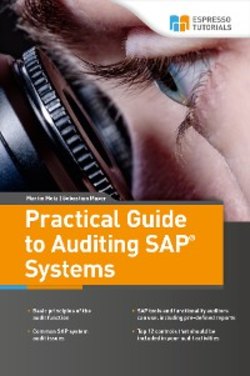Читать книгу Practical Guide to Auditing SAP Systems - Martin Metz - Страница 16
На сайте Литреса книга снята с продажи.
Оглавление2 The basic principles of auditing SAP systems
In this chapter, the focus moves from audit basics to the specifics of the SAP world. We also discuss the business relevance of SAP systems and introduce the general architecture of SAP systems to prepare for the SAP audit universe and its components. Furthermore, we also discuss two particular audit scenarios in an SAP environment. By the end of this chapter, you will know how to scope and prepare an SAP-specific audit.
2.1 Business relevance of SAP systems
Tens of millions of people around the world use SAP systems. Why? One apparent reason is that a lot of companies find it challenging to manage their business using hundreds or thousands of different systems. Once you separate the material and value flow of the factories in different systems, for example, it might be difficult to bring them back together and align them with each other. The higher the number of relevant systems with subsets of the required data that exist within a company, the more cumbersome a month-end or year-end process becomes.
Having separate sales, production, or accounting processes can quickly lead to inconsistencies and difficulties—a factor that motivates companies to invest in highly integrated systems instead.
This is where SAP comes into play: it offers an integrated business solution that ties together disparate procurement, sales, production, consolidation, and many other processes. Its market-leading Enterprise Resource Planning (ERP) systems are only one aspect. Other solutions offered by SAP include (https://www.sap.com/products.html; 01/01/2018):
ERP (for large, medium, and small enterprises)
Cloud and data platforms (e.g., SAP HANA platform, big data)
Procurement and networks (e.g., Supplier Management, Strategic Sourcing)
Analytics (e.g., Business Intelligence, Predictive Analytics)
Customer engagement and commerce (e.g., Sales, Marketing)
IoT and the digital supply chain (e.g., Manufacturing, Asset Management)
Human resources (e.g., Core HR and Payroll, Time and Attendance Management)
Finance (e.g., GRC, Financial Planning, Treasury Management)
SAP is most famous for its Enterprise Resource Planning solutions. Its market share within the ERP market has declined in recent years, but SAP still holds the top position with an estimated 19% of the entire market. According to the data available, SAP achieves the highest customer satisfaction by realizing more than 50% of the business benefits anticipated in an implementation. Every time a company requires an ERP solution, it is very likely that SAP will be shortlisted. Once SAP is shortlisted, the likelihood of being finally selected for the job is even higher (https://www.panorama-consulting.com/comparison-between-sap-oracle-and-microsoft-dynamics/).
